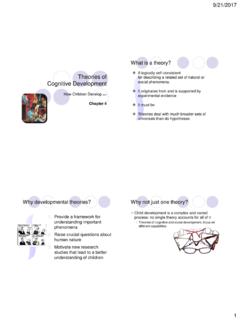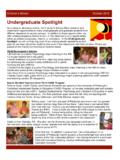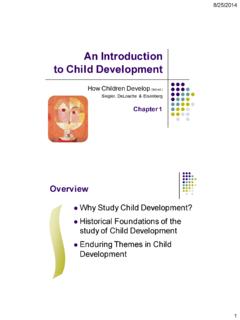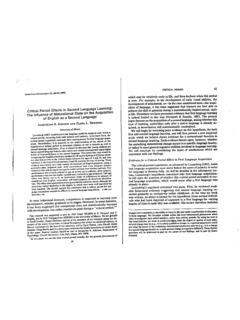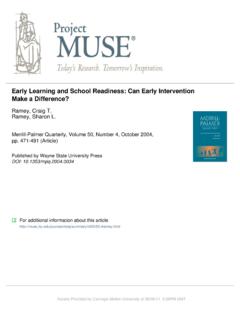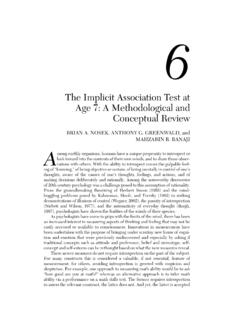Transcription of The misunderstood limits of folk science: an …
1 cognitive Science 26 (2002) 521 562. The misunderstood limits of folk science: an illusion of explanatory depth Leonid Rozenblit , Frank Keil Department of psychology , Yale University, 2 Hillhouse Avenue, Box 208205, New Haven, CT 06520-8205, USA. Received 20 August 2001; received in revised form 26 April 2002; accepted 3 May 2002. Abstract People feel they understand complex phenomena with far greater precision, coherence, and depth than they really do; they are subject to an illusion an illusion of explanatory depth . The illusion is far stronger for explanatory knowledge than many other kinds of knowledge, such as that for facts, procedures or narratives. The illusion for explanatory knowledge is most robust where the environment supports real-time explanations with visible mechanisms.
2 We demonstrate the illusion of depth with explanatory knowledge in Studies 1 6. Then we show differences in overconfidence about knowledge across different knowledge domains in Studies 7 10. Finally, we explore the mechanisms behind the initial confidence and behind overconfidence in Studies 11 and 12, and discuss the implications of our findings for the roles of intuitive theories in concepts and cognition. 2002 Leonid Rozenblit. Published by cognitive Science Society, Inc. All rights reserved. Keywords: Concepts; Epistemology; Meta-cognition; Knowledge; Overconfidence 1. Introduction Intuitive or lay theories are thought to influence almost every facet of everyday cognition. People appeal to explanatory relations to guide their inferences in categorization, diagnosis, induction, and many other cognitive tasks, and across such diverse areas as biology, physical mechanics, and psychology (Gopnik & Wellman, 1994; Keil, 1998; Murphy & Medin, 1985.)
3 Murphy, 2000). Individuals will, for example, discount high correlations that do not conform to an intuitive causal model but overemphasize weak correlations that do (Chapman & Chapman, . Corresponding author. Tel.: +1-203-432-6763; fax: +1-203-432-4623. E-mail addresses: (L. Rozenblit), (F. Keil). 0364-0213/02/$ see front matter 2002 Leonid Rozenblit. Published by cognitive Science Society, Inc. All rights reserved. PII: S 0 3 6 4 - 0 2 1 3 ( 0 2 ) 0 0 0 7 8 - 2. 522 L. Rozenblit, F. Keil / cognitive Science 26 (2002) 521 562. 1969). Theories seem to tell us what features to emphasize in learning new concepts as well as highlighting the relevant dimensions of similarity (Murphy, 2002). Intuitive theories have also been heavily emphasized in accounts of the cognitive development of children (Gelman & Koenig, 2002) and even of infants (Spelke, Breinliinger, Macomber, & Jacobson, 1992).
4 Concepts seem to be embedded within larger sets of explanatory relations that are essential to understanding the structure of the concepts themselves, how they are learned, and how they change over time. But even as theories have become more central to the study of concepts, it is also now evident that folk theories are rarely complete or exhaustive explanations in a domain (Wilson & Keil, 1998). Indeed, even the theories used daily to guide scientific research are now considered to be incomplete, or at least less formally logical than classical views assumed them to be (Boyd, 1991; Salmon, 1989, 1998). Science-in-practice is often driven by hunches and vague impressions. The incompleteness of everyday theories should not surprise most scientists. We frequently discover that a theory that seems crystal clear and complete in our head suddenly develops gaping holes and inconsistencies when we try to set it down on paper.
5 folk theories, we claim, are even more fragmentary and skeletal, but laypeople, unlike some scientists, usually remain unaware of the incompleteness of their theories (Ahn & Kalish, 2000;. Dunbar, 1995; diSessa, 1983). Laypeople rarely have to offer full explanations for most of the phenomena that they think they understand. Unlike many teachers, writers, and other profes- sional explainers, laypeople rarely have cause to doubt their na ve intuitions. They believe that they can explain the world they live in fairly well. They are novices in two respects. First, they are novice scientists their knowledge of most phenomena is not very deep. Second, they are novice epistemologists their sense of the properties of knowledge itself (including how it is stored) is poor and potentially misleading.
6 We argue here that people's limited knowledge and their misleading intuitive epistemology combine to create an illusion of explanatory depth (IOED). Most people feel they understand the world with far greater detail, coherence, and depth than they really do. The illusion for ex- planatory knowledge knowledge that involves complex causal patterns is separate from, and additive with, people's general overconfidence about their knowledge and skills. We therefore propose that knowledge of complex causal relations is particularly susceptible to illusions of understanding. There are several features of explanatory , theory-like knowledge that may converge to con- vince people they have vivid, blueprint-like senses of how things work, even when their actual knowledge is skeletal and incomplete.
7 One factor concerns a confusion between what is repre- sented in the head with what can be recovered from a display in real time. When people succeed at solving problems with devices they may underestimate how much of their understanding lies in relations that are apparent in the object as opposed to being mentally represented. We expect the representation/recovery confusion to be less important with other kinds of knowledge, , facts, narratives, or procedures. This confusion of environmental support with internal representation is related to a confu- sion that has been noted in the change blindness literature: people grossly overestimate their ability to remember what they have observed in a scene. This phenomenon, termed change blindness blindness, presumably occurs because people are mistaken about how visual infor- mation is stored they confuse their ability to acquire details by re-sampling a live scene with L.
8 Rozenblit, F. Keil / cognitive Science 26 (2002) 521 562 523. exhaustive, VCR-like storage of everything one sees (Levin, Momen, Drivdahl, & Simons, 2000). The confusion of environmental support for detailed representation might be expected to be strongest for phenomena that have perceptually vivid mechanisms. If we can see many of the working parts of a system, we may assume that the mechanisms can be easily internalized. But there is far more complexity in the interactions of the parts than is immediately apparent. Furthermore, as suggested by the change blindness literature, we may assume we remember vividly things we have seen as vivid. A second feature leading to the IOED may be a confusion of higher with lower levels of analysis. Most complex artificial and natural systems are hierarchical in terms of explanations of their natures.
9 In explaining a car one might describe the function of a unit, such as the brakes, in general terms, and then turn to describing the functions of subcomponents, such as pistons and brake pads, which in turn can be broken down even further. The iterative nature of explanations of this sort (Miyake, 1986) may lead to an illusion of understanding when a person gains insight into a high level function and, with that rush of insight, falsely assumes an understanding of further levels down in the hierarchy of causal mechanisms. This effect can easily happen for many natural and artificial systems with complex causal structures, especially those that have stable subassemblies. The concept of stable subassemblies was developed by Simon (1996) as a way of describing units in the hierarchical structure of complex systems that are sufficiently internally stable that they can be conceived of as an operational unit.
10 Confusion between higher and lower levels of analysis may be related to the confusion of en- vironmental support with representation, especially for perceptually vivid mechanisms which may trigger a sense of understanding at higher levels. For example, functional sub-assemblies that are easy to visualize and mentally animate may lead to strong (but mistaken) feelings of understanding at a high level of analysis, and thereby induce inaccurate feelings of compre- hension about the lower levels. A third feature of explanations leading to the illusion is related to the second: because explanations have complex hierarchical structure they have indeterminate end states. Therefore, self-testing one's knowledge of explanations is difficult. In contrast, determining how well one knows, , a fact, can be trivially simple.
